| Article ID | Journal | Published Year | Pages | File Type |
|---|---|---|---|---|
| 7740019 | Journal of Power Sources | 2013 | 9 Pages |
Abstract
An elastic deterministic contact mechanics model is applied to the compressed micro-porous (MPL) and catalyst layer (CL) interfaces in polymer electrolyte fuel cells (PEFCs) to elucidate the interfacial morphology. The model employs measured two-dimensional surface profiles and computes local surface deformation and interfacial gap, average contact resistance, and percent contact area as a function of compression pressure. Here, we apply the model to one interface having a MPL with cracks and one with a crack-free MPL. The void size distributions and water retention curves for the two sets of CL|MPL interfaces under compression are also computed. The CL|MPL interfaces with cracks are observed to have higher roughness, resulting in twice the interfacial average gap compared to the non-cracked interface at a given level of compression. The results indicate that the interfacial contact resistance is roughly the same for cracked or non-cracked interfaces due to cracks occupying low percentage of overall area. However, the cracked CL|MPL interface yields higher liquid saturation levels at all capillary pressures, resulting in an order of magnitude higher water storage capacity compared to the smooth interface. The van Genuchten water retention curve correlation for log-normal void size distributions is found to fit non-cracked CL|MPL interfaces well.
Related Topics
Physical Sciences and Engineering
Chemistry
Electrochemistry
Authors
I.V. Zenyuk, E.C. Kumbur, S. Litster,
